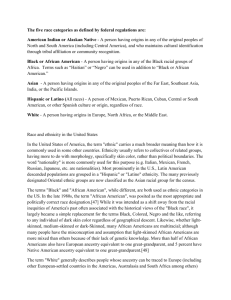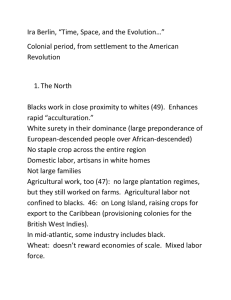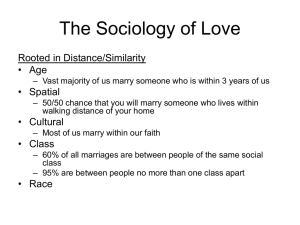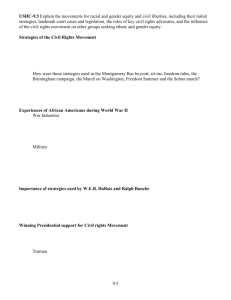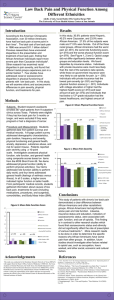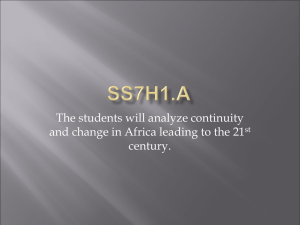Paper - Saint Mary's College
advertisement
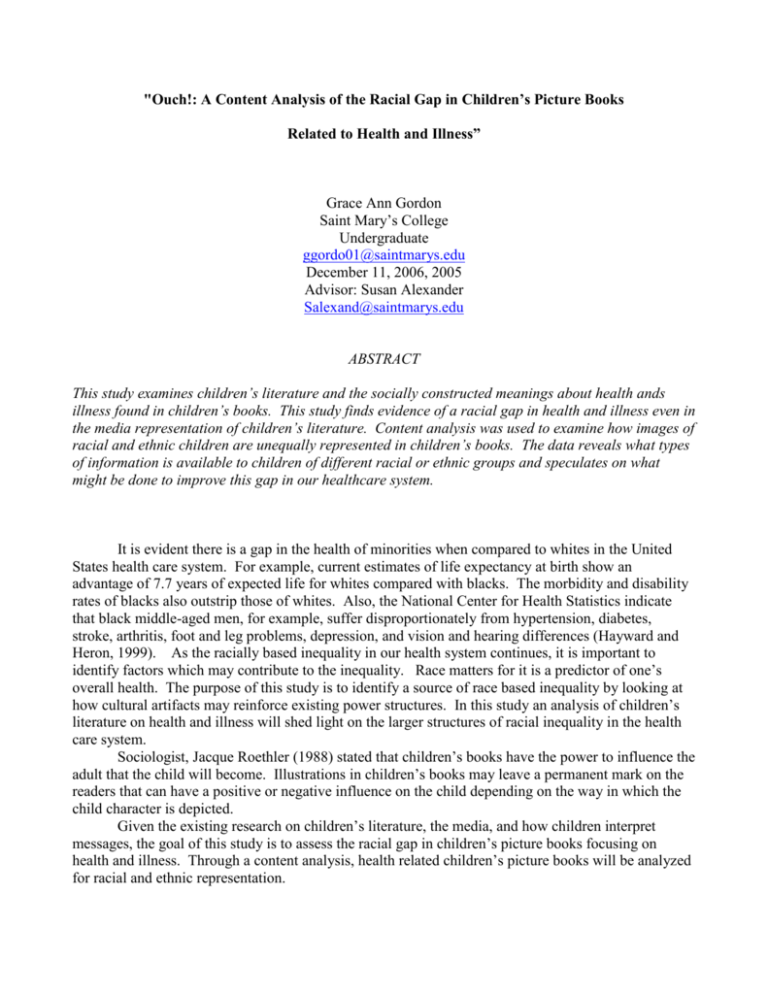
"Ouch!: A Content Analysis of the Racial Gap in Children’s Picture Books Related to Health and Illness” Grace Ann Gordon Saint Mary’s College Undergraduate ggordo01@saintmarys.edu December 11, 2006, 2005 Advisor: Susan Alexander Salexand@saintmarys.edu ABSTRACT This study examines children’s literature and the socially constructed meanings about health ands illness found in children’s books. This study finds evidence of a racial gap in health and illness even in the media representation of children’s literature. Content analysis was used to examine how images of racial and ethnic children are unequally represented in children’s books. The data reveals what types of information is available to children of different racial or ethnic groups and speculates on what might be done to improve this gap in our healthcare system. It is evident there is a gap in the health of minorities when compared to whites in the United States health care system. For example, current estimates of life expectancy at birth show an advantage of 7.7 years of expected life for whites compared with blacks. The morbidity and disability rates of blacks also outstrip those of whites. Also, the National Center for Health Statistics indicate that black middle-aged men, for example, suffer disproportionately from hypertension, diabetes, stroke, arthritis, foot and leg problems, depression, and vision and hearing differences (Hayward and Heron, 1999). As the racially based inequality in our health system continues, it is important to identify factors which may contribute to the inequality. Race matters for it is a predictor of one’s overall health. The purpose of this study is to identify a source of race based inequality by looking at how cultural artifacts may reinforce existing power structures. In this study an analysis of children’s literature on health and illness will shed light on the larger structures of racial inequality in the health care system. Sociologist, Jacque Roethler (1988) stated that children’s books have the power to influence the adult that the child will become. Illustrations in children’s books may leave a permanent mark on the readers that can have a positive or negative influence on the child depending on the way in which the child character is depicted. Given the existing research on children’s literature, the media, and how children interpret messages, the goal of this study is to assess the racial gap in children’s picture books focusing on health and illness. Through a content analysis, health related children’s picture books will be analyzed for racial and ethnic representation. 2 LITERATURE REVIEW Previous studies have shown there are racial inequalities in our health system. Hayward (1999) argues that blacks are consistently disadvantaged relative to whites across all major chronic disease and disabling conditions. Today, race and ethnicity remains a potent predictor of variations in health. The life experiences of blacks in the Untied States have been characterized by different patterns of education, economic success, and employment as well as different access to goods, resources, and privileges available within the larger society. According to Williams and Chaquita (1995), the decline in black economic well being and increase in black-white inequality is associated with worsening black health across a number of health indicators. The evidence of racial inequality in the health care system motivated my exploration of children’s picture books that address health illness issues to assess how accurately they reflect the racial and ethnic diversity of the United States. Harris (1990) claims that reading children’s books is beneficial because children can experience pleasure from the imaginative use of language and visual images. Schwarz (1999) proposed that illustrations in children’s books have a psychological effect upon children as picture books teach children how to deal with problems, how to model their lives, and how to stimulate being adults. Roethler (1998) argues that children absorb the images which remain with them for the rest of their lives. Children’s books and their illustrations have the power to influence the adult that the child will become because, according to Roethler (1998), pictures reveal allusions, associations, and overtones that reflect larger societal metaphors and symbols. Collier (2000) notes that while books have the power to promote favorable attitudes and foster positive behaviors on the part of their readers, the books must represent their audience in demographic terms. Purves and Beach’s (1972) research on reader responses to literature developed three basic conclusions: (1) readers are more interested in ideas and events which are relevant to their personal experience, (2) readers will seek out characters with whom they can identify, and (3) readers tend to favor characters that are most like themselves. For Collier (2000), the sense that one is “present” in the stories can stimulate children to develop a self identity of hope and meaning. According to Harris (1990), children’s literature serves the important role of mediator between children, cultural knowledge, and socialization by adults. Moreover, because children’s literature has long maintained this tradition in society, it possessed both symbolic and real power. However, when tradition is selective, or when it sets up inaccurate and damaging stereotypes, the meaning and knowledge shaped by traditions becomes significant, particularly if it shapes an individual’s perceptions of the world and his/her roles in it. Previous studies of children’s books indicate that depictions of African Americans have been stereotyped and narrowly focused. For example, African Americans tend to be relatively invisible in children’s literature, and when they do appear they are depicted in negative ways (Pescosolido 1997). Damaging stereotypes in children’s literature can have negative impact on children. In general, the children books publishing industry is not representative of the demographics of America (Johnson and Lewis 1998). Harris (1990) notes that African American children need words and illustrations that entertain, educate, touch the hearts, and ultimately leave them hopeful. If African American children are absent from the illustrations in picture books, how are they to judge their place in society? Bishop (1990) states that African American parents who provide their children access to many good quality children’s books about African Americans will aid in the development of literacy and contribution to children’s well- being. Such literature will reflect positive images to children, and help them learn how to stay strong in the world. “If African American children never saw pictures of themselves in books, they may come to conclusions that the best thing to do is to live vicariously through white, thus denying the rich cultures of African Americans (Roethler 1998, 97).” Absence of 3 self, Roethler (1998) argues, undermines self-perception, which is at the very root of the child’s thinking and may have extensive detrimental effects. Attitudes about health and behaviors are found in childhood. According to Turner (2006), the specific health related behaviors in children’s picture books may contribute to developing knowledge and understanding related to illness, injury, and health. African American children that are provided with access to quality children’s books about health and issues will develop a better understanding of health issues and contribute to their overall success in health. As Harris (1990) states, literature is a valued cultural tradition. Children’s picture books are indeed a valuable cultural commodity for children’s learning. The aim of my study is to analyze the racial gap in children’s picture books. Previous research found that in general the children’s publishing world is not representative of all of the voices of America. The American healthcare system also experiences racial inequality. Thus, if children from racial or ethnic groups are absent in books pertaining to health and illness, these groups may be at risk for more health problems throughout their lives. MEDIA THEORY The media can have a very strong influence on individuals today. Stuart Hall, a masscommunication theorist has conceptualized the process of media’s exchange of messages as a dynamic process. He describes the process as one of “encoding” and “decoding” media messages. The creation and subsequent interpretation of texts is referred to as “encoding” and “decoding.” To Hall (1974) there is no such thing as an uncoded message. In context, “decoding” involves not simply basic recognition and comprehension of what a text “says” but also the interpretation and evaluation of the text’s meaning with reference to relevant codes. The encoder-decoder model views communication as a process in which an idea or feeling is encoded into symbols by a source, transmitted to a receiver, and decoded into an idea or feeling (Fussell and Krauss 1992). According to this model, the basic unit of communication is the message, or in this case, the illustration or writing. The receiver must decode the message in order to arrive at the information he or she believes the illustration and writing is trying to portray. Hall (1974) argues the audience is the “source” as well as the “receiver” of the media messages. Any single message can have different meaning to various audience members; the receptions of them are not identical. Hall highlights both messages and their interpretations by audiences. One of the key contributions of this model is the way it interprets messages that are constructed according to certain “codes.” Hall (1974) explains that understanding or “decoding” messages requires knowledge of the conventions of the media and the workings of culture. Hall (1974, 3) claims “these decoded meanings “have an effect”, influence, entertain, instruct, or persuade, with very complex perceptual cognitive, emotional, ideological, or behavioral consequences.” The codes may not be perfectly symmetrical for people will misunderstand them differently in their communicative exchanges. Hall (1974, 4) argues that “In calling attention to the symbolic/linguistic coded nature of communications, the manner in which the interplay of codes and content serves to displace meaning from one frame to another.” Croteau and Hoynes (2003) argue that when a person is exposed to media whether it is watching television, scanning the newspaper, or looking at a fashion magazine, our ability to interpret the media depends on the familiarity with the basic codes of each medium. Media messages draw on a broader set of culture codes about how they believe the world really works. Codes are based on the assumptions that do not necessarily have to be included in the messages. Multiple meaning of the media texts occurs because of topics that are taken for granted by the audience. For example, news 4 stories, magazines and television assume certain definitions of beauty or success. They draw on layers of assumptions about relationships between men and women, parents and children, rich and poor and so forth. “Decoding then is the process whereby audiences use their implicit knowledge of both medium specific and broader cultural code to interpret the meaning of the text” (Croteau and Hoynes 2003, 276). According to Hall (1974, 3) “encoding and decoding focuses on the relationship between the media message, as it is constructed or “encoded” by media producer, and the ways that message is interpreted or “decoded” by the audiences.” Encoding and decoding are connected because they are processes that focus on the same media text, but a particular decoding does not necessarily follow from a specific encoded meaning. According to Croteau and Hoynes (2003), producers create media texts in ways that encode a preferred or “dominant” meaning. Interpretations that follow particular decoding are also based on the codes of the medium and the dominant assumptions that underpin any given culture. Morley (1980) proposed that the audience can do one of three things with these coded messages: people can read a preferred meaning, they can develop a “negotiated” reading, or they can draw on extratextual resources to construct an “oppositional” reading. Morley speculates as to which groups decode messages in line with the preferred meaning and which groups produce the negotiated oppositional meaning. As a particular audience children decode media texts including picture books on health and illness. Each child/audience member may decode a different message from the pictures based on their race, ethnicity, or nationality. Children, as the audience, act as active interpreters. If they come from different backgrounds, social networks, and defining experience, then it s likely there will be multiple interpretations of the same picture. METHODOLOGY Procedure Data for this study was collected through a content analysis. The objective of this analysis was to identify what messages children’s picture book reveal about the beliefs and values of a larger culture. The specific types of books coded were children’s picture books pertaining to health and illness issues. Content analysis is “a systematic analysis of the content rather than the structure of a communication, such as a written work, speech, or film, including the study of thematic and symbolic elements to determine the objective or meaning of the communication” (www.dictionary.com). Sample of Materials A sample of 60 books was obtained from three locations: Barnes and Noble, Borders, and the Wilmette Public Library. The reliability and overall values of a content analysis depends on the clear formulation of content categories and definitions or rules for assigning units to these content categories. Therefore, coding sheets were used to identify the following information: skin color of main character, skin color of other children characters, skin color of adults, language of the book, social status of characters, year book was published, and health issue being portrayed. The children’s books were sorted into eight categories including: human body, hospital experiences, nutrition, disability, diabetes, asthma, sickle cell, and other diseases. Hospital experiences books dealt with issues about children becoming familiar with hospitals and the professionals that worked there. They also included information about simple hospital procedures like checkups, X-rays, and broken bones. Human body books included topics on systems of the human body and how all the parts of the body work. Nutrition touched on topics of eating healthy, being obese, and understanding the food pyramid. 5 Disability books dealt with understanding that some children are born differently, and how to treat and react to them. This category also included books on sign language and mental disabilities. FINDINGS Table 1 illustrates the percentage of the race for each child on the cover of health and illness books. Overall, the largest percentage of children being displayed on the front cover of the books were white with (69%). This was followed by blacks (24%), Hispanics (3%) and Asians, (2%). For each table, Sickle Cell (S.C.) disease was left out of main data because this disease mainly affects blacks and would therefore alter the overall results. As noted in Table 1, the books on Sickle Cell disease showed only black children being portrayed on the front cover of the books. Table 1: Race of Child on Cover of Book H.B. H.E. Nutr. Dis. Diab. Asth. Other White 20 8 2 5 7 4 19 Black 7 2 1 3 2 2 5 Hispanic 1 0 2 0 0 0 0 Asian 0 0 0 1 1 0 0 Other 0 0 0 0 2 0 0 Total 30% 11% 5% 10% 13% 6% 25% Total 69% 24% 3% 2% 2% 100% White Black Hispanic Asian Other Total S.C 0 2 0 0 0 2 Total 0% 100% 0% 0% 0% 100% Table 2 shows the race of children portrayed inside the children’s books. Trends are similar to book cover with 60% white, 25% black, 5% Hispanic, and 9% of Asian children being represented in the books. Again Sickle Cell disease was separate out of the data but now, white comprised 13% of children inside these books with blacks 87%. Also, Asian children inside the books were represented slightly higher for this category. Table 2: Race of Other Children inside Book H.B. H.E. Nutr. Dis. Diab. Asth. White 185 25 21 51 23 23 Black 53 11 12 23 10 25 Hispanic 7 2 11 0 2 7 Asian 19 4 7 7 0 2 Other 0 0 3 2 0 0 Total 37% 6% 8% 12% 5% 6% Other 95 42 6 25 0 24% Total 60% 25% 5% 9% 1% 100% S.C White 3 Black 20 Hispanic 0 Asian 0 Other 0 Total 23 Total 13% 87% 0% 0% 0% 100% Table 3 shows the race of health care professional illustrated in the children’s books. The data reveals that 80% of health care professional are white, representing the majority of health care professionals portrayed. There were no Hispanic health care professionals while blacks accounted for 13% and Asians, 6%. Even for the category of Sickle Cell which Tables 1 and 3 found largely black characters, 89% of health care professionals were white and only 11% were black. 6 Table 3: Race of Health Care Professional H.B. White 18 Black 4 Hispanic 0 Asian 0 Other 0 Total 20% H.E. 52 7 0 5 0 60% Nutr. 1 0 0 0 0 1% Dis. 0 0 0 0 0 0% Diab. 5 0 0 0 1 5% Asth. 5 2 0 0 0 7% Other 5 1 0 1 0 7% Total 80% 13% 0% 6% 1% 100% S.C White 8 Black 1 Hispanic 0 Asian 0 Other 0 Total 9 Total 89% 11% 0% 0% 0% 100% DISCUSSION The data from this project clearly defines the unequal representation of minority children in children’s picture books pertaining to health and illness. Media Theory suggests that each reader may get a different message from the pictures, particularly with regar to the books’ characters. For example, the race of the healthcare profession in the books showed that healthcare professionals are white. Minority children may “decode” the message to be that doctors in the United States are white. Hispanic children may decode the image in yet another way because none of the children’s books represented Hispanic healthcare professionals. Even more stunning is that for the books on Sickle Cell disease, which affects mostly African Americans, one would also expect the doctors to be black characters, but only 11% of the healthcare professionals in these books were black. Given the importance of media representations in shaping children’s understanding of the world and their place in it, children’s books should represent all populations. Minority parents, however, face the problem of finding books for their children that represent their group. If an African American child sees white characters and white doctors, he/she may decode this to mean that white is better or they may not be able to relate to the everyday facts and issues about health and illness. While being under represented in a children’s picture book may not seem like it can affect one’s health, how children interpret or decode the messages may have a lasting impact on their health. Minority children are already at risk of having poor health so unequal representation in children’s literature may future increase their life chances or poorer health. References Anderson, Sterling, Ora. 1981. “Fiction for Young Black Reader: A Critique of Selected Books.” The Journal of Negro Education. 50: 75-82. Bishop, Rudine, S. 1990. “Walk Tall in the World: African American Literature for Today’s Children.” The Journal of Negro Education. 59: 556-565. Collins, Chiquita, and David R. Williams. 1995. “U.S. Socioeconomic and Racial Differences in Health: Patterns and Explanations.” Annual Review of Sociology. 21 Collier, Marta, D. 2000. “Through the Looking Glass: Harnessing the Power of African American Children’s Literature”. The Journal of Negro Education. 3: 235-242. 7 Croteau, David, and William Hones. 2003. Media Society. 3rd edition. Thousand Oaks, CA: Pine Forge Press. DeLamater, John D. and Daniel J. Meyers. 2007. Social Psychology. 6th edition. Belmont, CA: Thompson Wadsworth. Fussell, S. R., and S.R. Krauss. 1992. “Coordination of knowledge in common action: Effects of speakers’ assumptions about what others know.” Journal of Personality and Social Psychology. 62: 378-391. Hall, Stuart. 1974. “The Television Discourse-Encoding and Decoding.” In Studies in Culture: An Introductory Reader, ed. Ann Gray and Jim McGuigan. London: Arnold, 1997. pp28-34. Harris, Violet J. 1990a. “African American Children’s Literature: The First One Hundred Years.” The Journal of Negro Education. 59: 540-555. Harris, Violet, J. 1990b. “Benefits of Children’s Literature.” The Journal of Negro Education. 4: 538-539. Hayward, Mark. D, and Melonie Heron. 1999. “Racial Inequality in Active Life Among Adult Americans.” Demography. 46: 77-91. Johnson, Dianne, and Catherine E. Lewis. 1998. “Introduction: [Children’s and Young-Adult Literature.]” African American Review. 32:1. Lau, Richard, R. and Steven Klepper. 1988. “The Development of Illness Orientations in Childhood Aged 6 through 12.” Journal of Health and Social behavior. 2: 149-168 Morley, David. 1980. The 'Nationwide' Audience: Structure and Decoding. London: BFI Pescosolido, Bernice, A., Elizabeth Grauerholz, and Melissa A. Milkie. 1997. “Culture and Conflict: The Portrayal of Blacks in U.S. Children’s Picture Books Through the Mid and Late Twentieth Century.” American Sociological Review. 3:443-464. Purves, A. and Beach, R. 1972. Literature and the reader: Research to literature, reading interests and the teaching of literature. Urbana, Illinois: NTCE. Roethler, Jacque. 1998. “Reading in Color: Children’s Book Illustrations and Identity Formation for Black Children in the United States.” African American Review. 32: 95-105. Tolson, Nancy. 1998. “Making Books Available: The Role of Early Libraries, Librarians, and Booksellers in the Promotion of African Americans Children’s Literature.” African AmericanReview. 1:99-16. Turner, Joan. 2006. “Representations of Illness, Injury, and Health in Children’s Picture Books.” Children’s Health Care. 35: 179-189. 8 Content Analysis. (n.d.). The American Heritage® Dictionary of the English Language, Fourth Edition. Retrieved November 12, 2006, from Dictionary.com website: http://dictionary.reference.com/browse/content analysis


